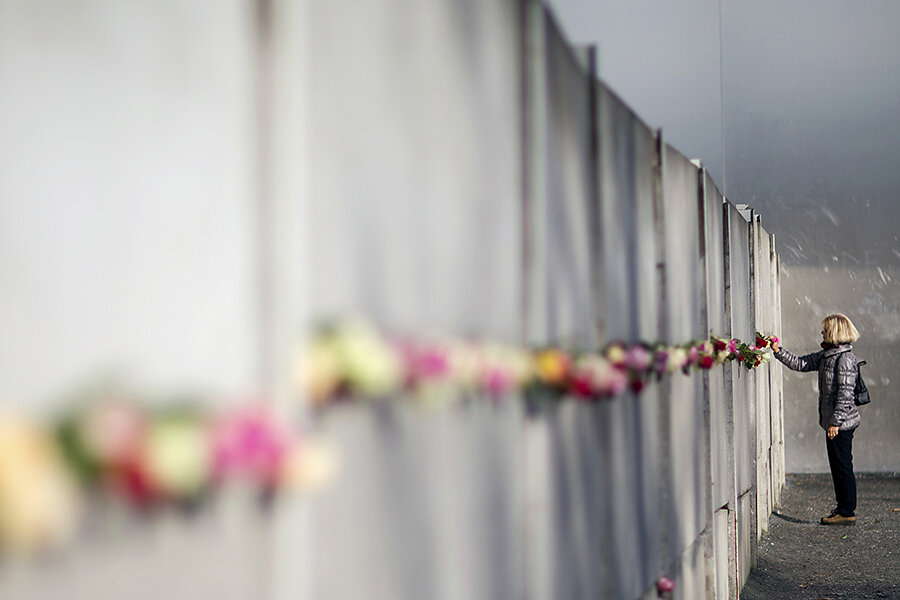Leaving their mark: Tourists put Berlin Wall at risk
Loading...
| Paris
On this day today, in 1989, the Berlin Wall was breached, bringing down one of the starkest divisions of the cold war. What remains of the wall today is pondered by 3 million tourists a year, who come to glimpse history’s constant passing. Guenter Schabowski, in fact, the man who inadvertently prompted a rush to the wall on that Nov. 9 when he said it was open “immediately without delay,” died just this month.
But now, authorities say they’re being forced to erect a new barrier – this one to protect the cold war relic itself, from tourists and others who etch their names in the wall or take pieces of it home.
The Berlin Wall has long tempted visitors to leave a mark – an impulse that some argue is centuries old. But a renovation project to preserve the East Side Gallery, a nearly one-mile section of the wall that contains 100 murals that were painted by international artists in 1990 after it was breached, has been defaced as quickly as it began. And authorities say they’ve had enough.
“We have witnessed in recent weeks and months an unbelievable amount of vandalism," said Sascha Langenbach, a spokesman for the Friedrichshain-Kreuzberg district, at a news conference.
Now tourists who could once get right up to the wall will be forced to view this section through a transparent barrier, about 2 1/2 feet high and 4 feet away, according to German broadcaster Deutsche Welle. Authorities also say they’ll lay down a plaque reminding visitors that the Berlin Wall is a protected monument, not a public souvenir. They hope this cuts down graffiti by about 90 percent.
Maria Lombard, a professor of travel writing at Northwestern University’s branch in Qatar, say that travelers have always had the impulse to leave their mark. “Travelers want to try to connect with the place they are going,” she says.
But an increasing number of tourists, as well as social media that has underscored recording rather than experiencing foreign locales, is threatening to tilt tourism toward the destructive.
“We have to find a balance,” Ms. Lombard says. “First off we have to protect historic sites. But we need to find ways for tourists to express their connection to a place.”
Love locks
Berlin officials are not alone in scrambling for a new balance. This summer, officials in Paris removed 700,000 padlocks, weighing 44 tons, from an iconic bridge, the Pont des Arts, in front of the Louvre in the French capital. The locks, attached by couples as a “sweetheart” act, started to weigh down the fencing on the bridge, threatening passersby below. Now, in the place of fencing, authorities have erected glass paneling that can’t be clamped.
If the structures that attract “love locks,” a phenomenon that has spread across the globe, and the impulse to mar the Berlin Wall are threatened by the acts of many, the behavior of individual tourists can be just as damaging. A Chinese tourist raised a global storm in 2013 after he etched his name “Ding Jinhao was here” on a 3,500-year-old panel of the Temple of Luxor in Egypt. Others have offended sensibilities everywhere from the Coliseum in Rome (via graffiti) to the top of Mount Kinabalu in Malaysia (by posing naked for photos).
Indeed there have been increasing cases – or at least increasing evidence – of tourists disrespecting holy and historic sites and structures – and often taking a “selfie” to prove it.
The “selfie” is, in some cases, seen as the answer. At a dozen-odd other bridges in Paris, the city urges tourists to take selfies and post them with the hashtag #LoveWithoutLocks.
But others see the “selfie” as part of a deeper cultural problem. Sarah Hampson, a columnist for the Globe and Mail, took this new breed of tourist to task this summer.
“The locks are an imposition from strangers who somehow want to ‘own’ their moment in a foreign place – not unlike the hikers who stripped naked upon summiting a peak in Malaysia or the plethora of selfie-takers,” she writes. “People put their presence above the historic and cultural importance – not to mention the beauty – of the places they’re visiting.”
The downside of tourism
None of this is new. The “love locks” of Paris began appearing in 2008, some say inspired by a century-old story from Serbia, others by a popular Italian book from the last decade. Lombard argues the impulse hearkens back to cave paintings. But what is new is the number of travelers reaching the farthest corners of the globe.
According to the United Nation’s World Tourism Organization, the number of international tourists continues to grow, from 25 million in 1950 to 278 million 30 years later, to 527 million in 1995, and to 1.13 billion last year.
That presents new opportunities for both traveler and place traveled, but also new challenges. Some mayors, such as Ada Colau of Barcelona, have been so fed up with international travelers disturbing locals – mostly with alcohol-fueled public rowdiness – that they’re aiming to limit the numbers of tourists.
“The sense of respect is just not there anymore,” Lombard says. There is a “I got a good deal so I’m gonna go mark up the rest of the world” mentality that is the underside of mass tourism that hurts everyone, including tourists themselves.
In response to a Guardian story about the Berlin Wall’s new barriers, one lamented: “The 'Berlin Fence' doesn't have the same ring to it.”
Another writes: “People only care about themselves these days and what they can do for them. Translates into every aspect of life. It's just me, me, me.”









